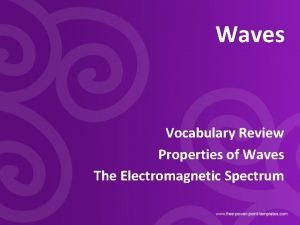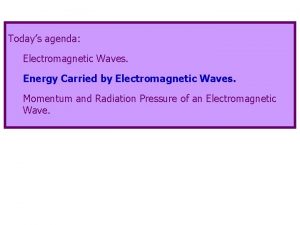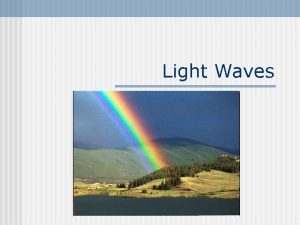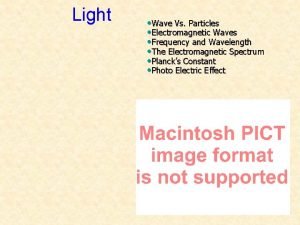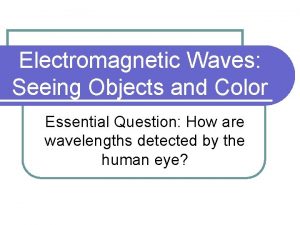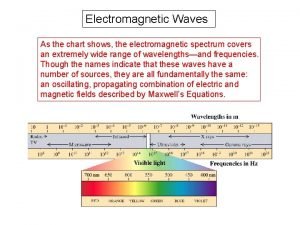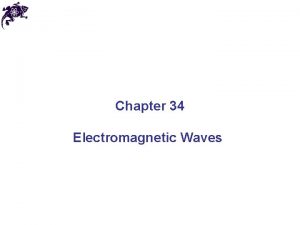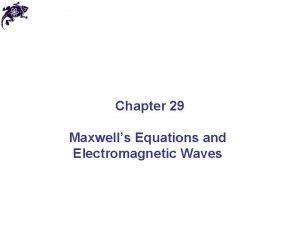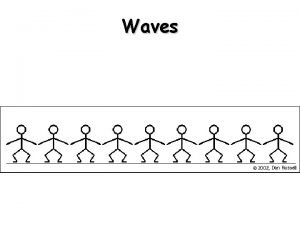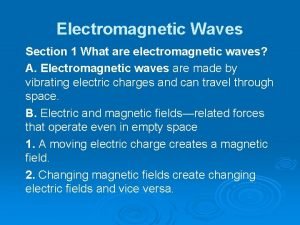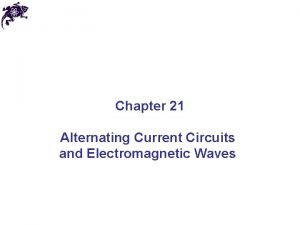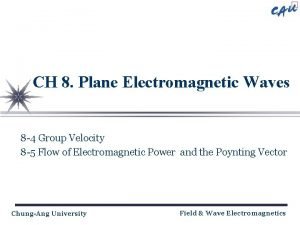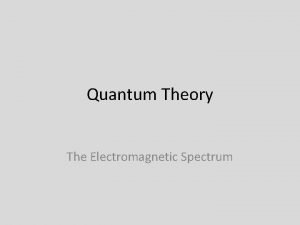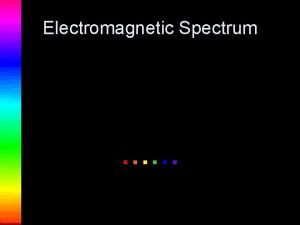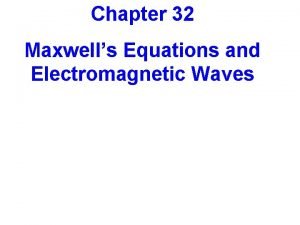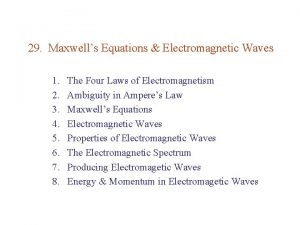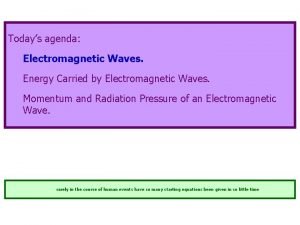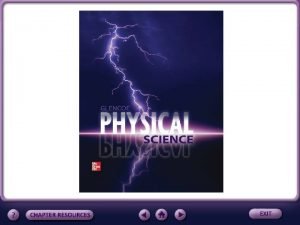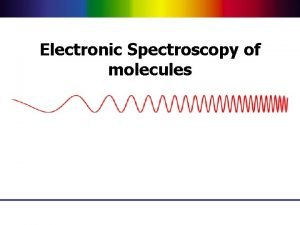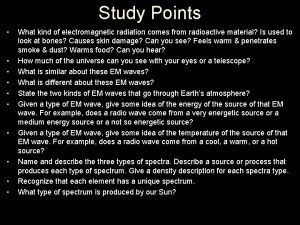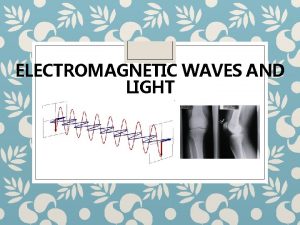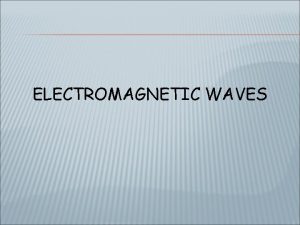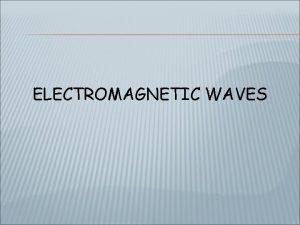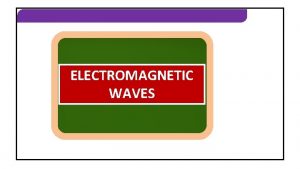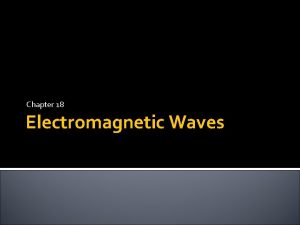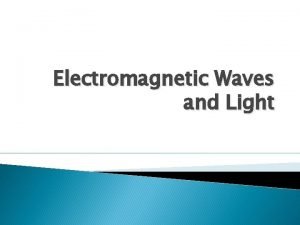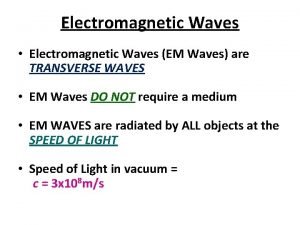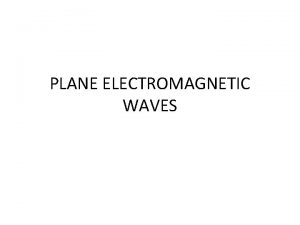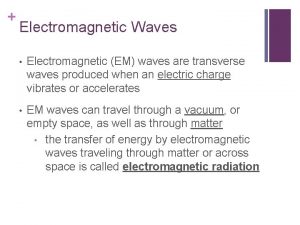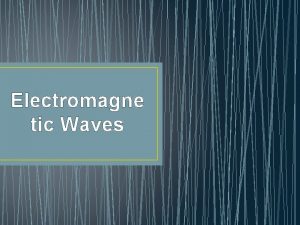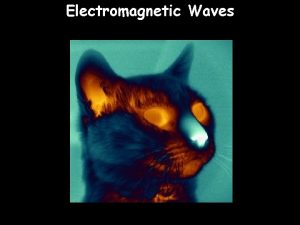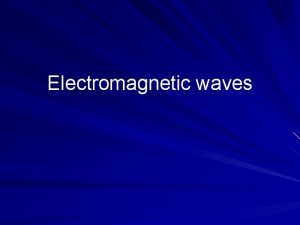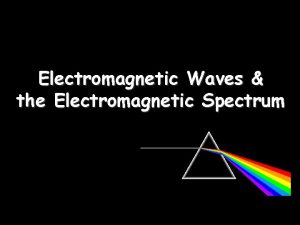Chapter 18 Electromagnetic Waves Ch 18 1 Electromagnetic

































- Slides: 33

Chapter 18 Electromagnetic Waves

Ch 18. 1 – Electromagnetic Waves A. Electromagnetic Waves are produced by charged particles in motion 1. They can travel through empty space to transmit energy

B. EM Waves are composed of 2 force fields – electric & magnetic 1. Force field – an area within which a force is exerted a) Ex: Earth’s gravity field – exerts a downward force on all objects and extends into space

2. Magnetic Field – exerts a force on other magnets causing them to line up in the direction of the magnetic field

3. Electric Field – field surrounding a charged particle that exerts a force on all other charged particles

4. A moving charged particle is surrounded by an electric and magnetic field 5. As the charged particle moves up and down it produces an electromagnetic wave Electric Field Magnetic Field

C. EM Waves have wavelength and frequency 1. One complete vibration (up and down) of the charged particle generates one wavelength 2. The number of wavelengths that pass a point per second is the frequency

D. Radiant Energy – energy carried by an electromagnetic wave 1. The amount of energy carried by an EM wave is determined by ` its frequency 2. The higher the frequency, the more energy the wave has

E. EM Waves all travel at the speed of light – 300, 000 km/s in space (about 186, 000 miles/second)

Ch 18. 2 – The EM Spectrum A. EM Waves have a series of different frequencies and wavelengths called the EM spectrum 1. Since they all travel at the same speed radiant energy decreases as wavelength increases

Electromagnetic Spectrum

B. Radio Waves – have the lowest frequency and carry least energy 1. AM/FM radio and television signals are types of radio waves 2. They are sent and received by antennas

a) Transmitting antenna – piece of metal in which electrons can vibrate to produce an EM wave b) Receiving antenna – device that vibrates when in contact with radio waves, producing an electric current

Radio Wave Transmissions


C. Microwaves - have slightly higher frequencies than radio 1. Used for portable and cellular phones as well as to heat food

D. Infrared Waves – heat waves; feel warm or hot 1. Infrared detectors sense objects that are warmer or colder than their environment 2. Some animals such as piranhas and some snakes can detect infrared to help find prey

E. Visible Light – aka white light 1. Different colors are EM waves of different wavelengths 2. Red light has the longest wavelength, violet has the shortest

F. Ultraviolet Radiation – frequencies high enough to damage cells 1. Too much exposure can cause sunburn or skin cancer 2. Since it can kill cells, they may be used to sterilize equipment

3. The ozone layer protects the surface by absorbing much of these rays

G. X-rays –frequencies so high can go right through skin and muscles 1. Too much exposure can damage or kill cells 2. Useful in medical diagnosis with proper precautions

H. Gamma Rays – EM waves with the highest frequency (strongest radiation) 1. Produced by nuclear decay 2. Can also be used to kill bacteria on equipment or in food

3. Can cause changes in DNA resulting in cancer or other abnormalities however can also be used to treat cancer tumors

4. Gamma ray bursts – extremely energetic explosions of gamma rays from distant galaxies Hubble Image Artist Interpretation

Illustration of a gamma ray burst hitting a planet like Earth.

Ch 18. 3 – Uses of EM Waves A. The world has become connected by various forms of telecommunication which make use of EM waves

B. Radio waves are the wave of choice for most telecommunications 1. The assigned frequency for a radio or TV station is its carrier wave

2. Amplitude modulation – amplitude of the carrier wave is changed to transmit information 3. Frequency modulation – frequency of the carrier wave is changed

C. Telephones 1. Convert sound waves to electrical signals which then are turned into a radio or microwave 2. Receivers convert the radio/micro back to electrical signal then speaker converts it back to sound wave

D. Communication Satellites – enable radio/microwave signals to be sent from one part of Earth to another

D. Radar – uses radio waves to locate objects by measuring the time it takes for the wave to reach the object, reflect and return

E. Global Positioning System – consists of satellites, ground stations and portable receiver units to locate objects on Earth

 What waves do not require a medium
What waves do not require a medium Light and sound travel in waves true or false
Light and sound travel in waves true or false Mechanical waves examples
Mechanical waves examples Similarities of mechanical waves and electromagnetic waves
Similarities of mechanical waves and electromagnetic waves Difference between matter waves and electromagnetic waves
Difference between matter waves and electromagnetic waves Mechanical vs electromagnetic
Mechanical vs electromagnetic Mechanical and electromagnetic waves similarities
Mechanical and electromagnetic waves similarities Mechanical and electromagnetic waves
Mechanical and electromagnetic waves A health inspector is measuring the intensity of a sound
A health inspector is measuring the intensity of a sound Energy density in em waves
Energy density in em waves Electromagnetic waves characteristics
Electromagnetic waves characteristics Electromagnetic waves frequency
Electromagnetic waves frequency Electromagnetic waves: seeing objects and color
Electromagnetic waves: seeing objects and color Electro magnetic chart
Electro magnetic chart Electromagnetic waves powerpoint template
Electromagnetic waves powerpoint template Hertz experiment electromagnetic waves
Hertz experiment electromagnetic waves Electromagnetic waves formula
Electromagnetic waves formula Electromagnetic waves def
Electromagnetic waves def Electromagnetic wave spectrum song lyrics
Electromagnetic wave spectrum song lyrics Section 1 what are electromagnetic waves
Section 1 what are electromagnetic waves Alternating current circuits and electromagnetic waves
Alternating current circuits and electromagnetic waves Power of electromagnetic wave
Power of electromagnetic wave Electromagnetic wavelength formula
Electromagnetic wavelength formula Electron spectrum
Electron spectrum The phenomenon of diffraction can be understood using *
The phenomenon of diffraction can be understood using * Energy of em wave
Energy of em wave Right hand rule for em waves
Right hand rule for em waves Concept of electromagnetic waves
Concept of electromagnetic waves Energy carried by electromagnetic waves
Energy carried by electromagnetic waves Emw spectrum
Emw spectrum Section 1 what are electromagnetic waves
Section 1 what are electromagnetic waves Electromagnetic waves table
Electromagnetic waves table What type of electromagnetic waves cause sunburns? *
What type of electromagnetic waves cause sunburns? * Characteristics of a longitudinal wave
Characteristics of a longitudinal wave








